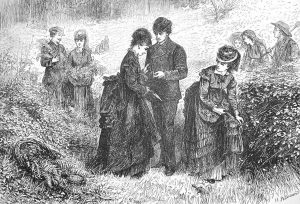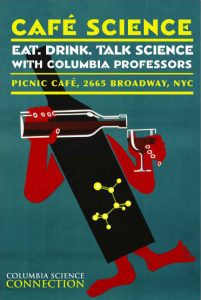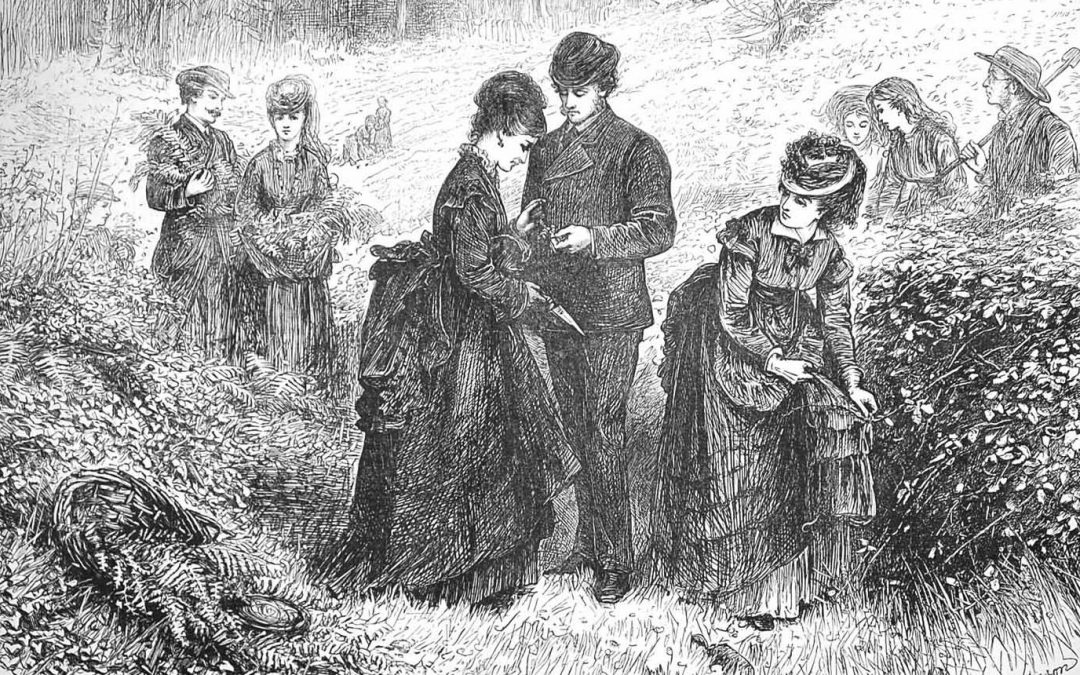Some thoughts about the sociological and historical background of the recent participatory turn in science and society
Responsible science, public science and citizen science are iridescent concepts. Media and advocates of these concepts link them with positive ideals like participation, egality, openness, social responsibility, and environmental conservation. This creates the image of a new research culture, which aims to fit the needs of the 21st Century. No longer only professional scientists (in their isolated laboratories) are the producers of scientific knowledge but also “common people” get the chance to involve themselves beyond deliberation and by getting part of the actual process of knowledge production. Scientific knowledge gets finally democratized – this is the picture. But why is this happening right now? This blog entry embarks a historical and sociological quest for answers. It is based on the German article “Entfremdung, Entzauberung und eine ungenügende Öffentlichkeitskonzeption”, which was published in the OEAD’News 101 in October 2016.
This original work is accessible here: https://www.oead.at/fileadmin/oead_zentrale/ueber_den_oead/publikationen/pdf/oead.news/2016/WEB_oead_news_101.pdf
A short relational history of science and society
The entanglement of science and society can be described as a relational history. In this, cooperation and participation are the norm, while a sharp delineation of certified experts and laypersons is a special characteristic of the late 19th and 20th Century (Nikolow and Schirrmacher 2007). With responsible science, public science and citizen science both societal sub-systems seem to re-enter their former, participatory, modus operandi.
When modern science was developed between the 17th and 19th centuries, it was a open and public enterprise. Science spectacles and public experiments of the ancien régime proof this as well as the networking activities of Charles Darwin, Alfred Russel Wallace, Gregor Mendel, and Carl Linnaeus. All these scientists, who are now celebrated as individuals, depended on broad networks of local providers of information, who were recruited from all social strata. The aim of this kind of science was to unfold the book of nature by gathering as many natural-historical information as possible. A thinking style that provoked collaboration and public work on scientific questions.
A first demarcation occurred in the second half of the nineteenth century. In this period many sciences took the step from a dense description of reality to an experimental viewpoint, in which the investigation of causes and effects advanced the ideal of undisturbed test conditions. Individual local descriptions were no longer required, but rather a specified and reproducible knowledge for dealing with highly complex experimental systems. For ordinary citizens, the access to this elaborated world became increasingly difficult.

Figure 1: Pteridomania: Laymen botanicists with scientific reputation in the year 1873
(Source: http://allday.com/post/7578-10-strange-recreational-pastimes-victorians-actually-enjoyed/)
Around 1900 science began implicitly to adapt more and more to rely on the working concept of division of labour (in correlation with the social differentiation of western societies themselves). In the course of this it became to a greater extent effective. Plenty of the technological success (and horrors) in the 20th century seems to be a result of this division. Gradually the nimbus of scientists as producers of clear and objective knowledge developed. Specialization and experimentalisation, however, led to a functional alienation from the public, which contributed to the emergence of the image of a distinct “truth cast”. The public was now framed as audience and no more as co-producers. Scientists were, among other things, depicted in their media representation as janus-faced. Partially frightening as Stanley Kubricks’ “Dr. Strangelove”, but also particularly trustworthy, as (for example) the German animal expert and popular-scientist Bernhard Grzimek or the French adventurer Jacques Cousteau. Institutional science and its popularizers stood for objective, instructive, knowledge but it was also perceived sometimes as something esoteric, sometimes frightening.

Figure 2: Dr. Strangelove 1964, Stanley Kubrick (Source: http://www.imdb.com/title/tt0057012/)

Figure 3: Bernhard Grzimek 1971 in TV Studio with Cheetah
(Source: http://www.kreisblatt.de/lokales/main-taunus-kreis/PR-Talent-mit-Marotten;art676,375241)
Science as resource for political decisions
In the second half of the 20th century, politicians “discovered” science as a decision-making resource for questions about the implementation of new technologies in society. Scientists have now been framed as experts for topics such as nuclear power, genetic engineering, etc. The political system approached the scientific system to produce clear statements to generate a capacity to act in relation to specific technology related issues. However, science gained the same degree of complexity and diversity as it had acquired credibility as source for (at least rhetorically) unambiguous knowledge. In the 1980s and 1990s this led to a system-related disenchantment of public expectations in science and a shattering of trust in the (western) “truth cast” itself. This became evident, for example, in the Europe-wide discussions on the consequences of Chernobyl, but also in the discourse about climate-change beginning in the 1990s. When “suddenly”, those from whom clear statements about knowledge were expected fought out public disputes and interpreted the data material available to them in different ways.
In addition a serif-confident critique rose in western societies towards the implementation of science related technologies like genetic engineering as well as the communication of their consequences. In general, a linear deficit model of science and society prevailed. Some produce, spread and explain knowledge (scientists), the citizens (whose everyday life in modern societies is determined by this knowledge) are conceptualized as passive recipients. On the basis of scientific knowledge, however, decisions (by politicians) were framed as been made in “their sense”. The anti-nuclear power movement, science shops and other citizen driven (or as “for” citizens framed) actions were the first initiatives that reacted to this paternalistic conception of dissemination, explanation and decision making.
Since the turn towards the 21st Century, according to science sociologist Peter Weingart, science had become aware that the paternalistic implications of its public conception no longer fits into the political culture characterized by democratic claims about participation. In the 2000s, the “Public Engagement in Science and Technology” program in the United States and the UK and the “Science in Dialogue” program in Germany were the first dialogical (but not yet fully “participatory”) reactions – besides of the consensus conferences of the 1980s.
The current participatory turn
Responsible science, public science and citizen science are products of this relational history. They can be understood as an expression of a social desire to overcome deficits in the relationship between science and society. The emergence of these deficits were a specific feature of the 20th century.
For example, the citizen science movement is not only trying to revive the role of the classic amateur as a knowledge producer, but also links itself methodologically to the working modes of natural history by inviting public researchers to collect large amounts of data on a wide variety of topics.
Through a strong focus on shared-decision making and social responsibility, many projects, which operate under the label of responsible science seek to re-establish the trust of citizens in science by overcoming the paternalism of past scientific communication and social intervention. Local stakeholders, for example, integrate their local expertise and knowledge into the research process. In addition, the impact on local nature and local society is being critically reflected.
This contain similarities to the concept of public science. Public science tries to end the social alienation by new forms of presenting research within the public sphere. For example within so-called science cafés.

Figure 4: Poster of the Columbia Café Science from June 2006 (Source: http://alumni.columbia.edu/newsletter/ecards/science_cafe_062006.html)
However, it is still undecided if the complex relationship between science and society becomes now (again) more integrated or if the “new participatory” turn just reaffirms old boundaries. The clear division of labour in many crowdsourced citizen science projects appears to indicate a tendency for the second.
Further readings
Mahr, D. Citizen Science: Partizipative Wissenschaft Im Späten 19. und frühen 20. Jahrhundert. 1. Auflage. Wissenschafts- und Technikforschung, Vol. 12. Baden-Baden: Nomos, 2014.
Nikolow, S. and A. Schirrmacher, “Wissenschaft, Politik und Gesellschaft: Deutschland im Internationalen Zusammenhang im Späten 19. und 20. Jahrhundert.,” eds. Wissenschaft Und Öffentlichkeit Als Ressourcen Füreinander: Studien Zur Wissenschaftsgeschichte Im 20. Jahrhundert. Frankfurt/Main ; New York: Campus, 2007.
Strasser, B. J. “The Experimenter’s Museum: GenBank, Natural History, and the Moral Economies of Biomedicine.” Isis; an International Review Devoted to the History of Science and Its Cultural Influences 102, no. 1 (March 2011): 60–96.
Weingart, P. Die Wissenschaft Der Öffentlichkeit: Essays Zum Verhältnis von Wissenschaft, Medien Und Öffentlichkeit. 1. ed. Weilerswist: Velbrück Wissenschaft, 2005.
Weingart, P., A. Engels, P. Pansegrau, and T. Hornschuh. Von der Hypothese zur Katastrophe: der anthropogene Klimawandel im Diskurs zwischen Wissenschaft, Politik und Massenmedien. 2. ed. Opladen: Budrich, 2008.


Nice introduction! I am curious to find out more about the “insufficent concept of the public” you mention in your title. Could you elaborate that? Besides the points you are making above, is it not also imperative to include the importance of (sources of) research funding and the role of Big Business in it (often “Merchants of Doubt”)? The latter might also contribute to the disenchantment, no?